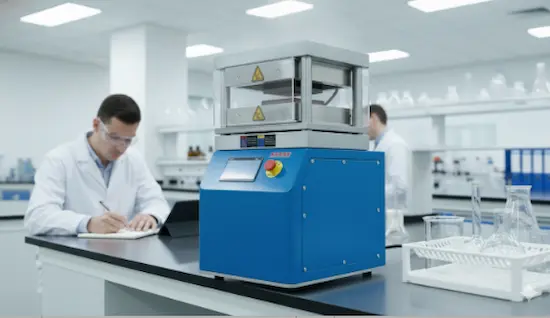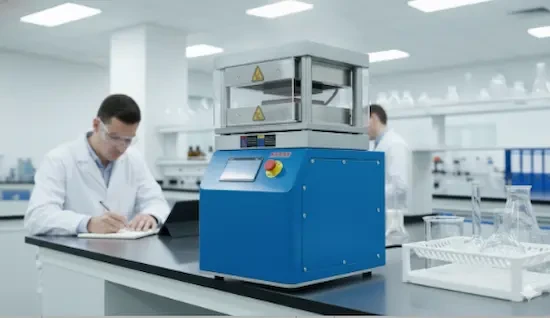É uma cena familiar em muitos laboratórios: o zumbido constante e potente da prensa hidráulica em funcionamento. Mas um dia, você passa e sente uma onda de calor irradiando da máquina. Você coloca a mão na carcaça – não está apenas morna, está quente. Você pode descartar isso como um efeito colateral de uma carga de trabalho pesada.
Mas uma semana depois, durante um procedimento crítico, a prensa geme, desacelera e para com um solavanco. Uma pequena poça escura de fluido hidráulico começa a se formar no chão. Seu projeto agora está em espera e um reparo caro é iminente.
O Ciclo Caro de "Esfriar e Quebrar"

Se este cenário parece familiar, você não está sozinho. Em inúmeros ambientes de pesquisa e produção, uma prensa hidráulica superaquecida é frequentemente tratada como um incômodo menor, em vez do sinal de alerta crítico que realmente é.
A resposta típica é reativa. Deixamos a máquina "esfriar" por uma hora. Completamos o fluido. Podemos até registrá-la para a próxima manutenção programada. Mas estas são soluções temporárias para um problema que está silenciosamente drenando seus recursos.
As consequências comerciais são concretas e severas:
- Contas de Energia Disparadas: Esse calor excessivo é literalmente energia desperdiçada. Uma prensa superaquecida é uma prensa ineficiente, consumindo mais eletricidade para realizar a mesma quantidade de trabalho.
- Autodestruição Acelerada: O calor é o inimigo número um dos componentes hidráulicos. A regra geral é clara: para cada aumento de 10°C (18°F) na temperatura acima da faixa ideal de 60°C (140°F), a vida útil funcional do seu fluido hidráulico e das vedações de borracha é reduzida pela metade. Sua máquina está cozinhando ativamente por dentro.
- Tempo de Inatividade Não Planejado e Catastrófico: Uma prensa que funciona consistentemente quente é uma prensa destinada a falhar. Não é uma questão de "se", mas de "quando". Seja uma vedação rompida, uma bomba travada ou uma válvula entupida, o resultado é sempre o mesmo: uma parada súbita e completa na produção que compromete prazos e destrói orçamentos.
O Verdadeiro Culpado: O Calor é Apenas Energia Desperdiçada Disfarçada
A razão pela qual essas "soluções" comuns falham é que elas confundem o sintoma – o calor – com a doença. Para resolver o problema, devemos parar de perguntar "Como vamos esfriar?" e começar a perguntar "De onde vem todo esse calor?"
A resposta é simples: o calor é a evidência física da ineficiência. Em um sistema perfeito, toda a energia seria usada para realizar trabalho. Na realidade, a energia é perdida, e essa energia perdida é liberada como calor.
Existem duas fontes principais desse desperdício de energia em uma prensa hidráulica:
1. Fricção e Restrição do Fluido
Imagine tentar forçar água através de uma mangueira de jardim mal dobrada. A área na dobra fica quente e o fluxo é fraco. O mesmo acontece dentro da sua prensa. À medida que o fluido hidráulico é forçado através de mangueiras subdimensionadas, curvas acentuadas ou filtros parcialmente bloqueados, uma fricção imensa é gerada. Essa turbulência converte uma enorme quantidade de energia diretamente em calor, em vez de força útil.
2. Quedas de Pressão Sem Trabalho
Quando o fluido de alta pressão encontra um caminho para uma área de menor pressão sem mover um pistão ou girar um motor – por exemplo, fluindo por uma válvula de alívio – sua energia potencial é instantaneamente convertida em energia térmica. O sistema está trabalhando duro para gerar pressão, apenas para que essa energia seja dissipada como calor que prejudica o desempenho.
É por isso que simplesmente deixar a máquina esfriar é uma estratégia perdedora. Você está apenas esperando o sintoma diminuir temporariamente, enquanto a causa raiz – os vazamentos internos de energia – permanece, pronta para causar outro ciclo de superaquecimento assim que você reiniciar.
Projetado para Estabilidade: A Diferença Entre Combater o Calor e Preveni-lo

Para resolver permanentemente o problema de superaquecimento, você deve abordar sua fonte: a ineficiência energética. Isso requer mais do que uma solução rápida; exige um sistema projetado para estabilidade térmica desde o início.
É aqui que a filosofia de design por trás de equipamentos de laboratório confiáveis se torna crítica. Uma prensa hidráulica verdadeiramente robusta não é apenas construída para ser poderosa; é projetada para operação sustentada e eficiente. Não é uma ferramenta de força bruta; é um instrumento de precisão.
Isso é alcançado garantindo que o sistema seja projetado para minimizar a perda de energia em primeiro lugar. Isso significa:
- Componentes de Tamanho Correto: Mangueiras, tubos e válvulas são dimensionados para permitir que o fluido flua suavemente, não para serem forçados através de gargalos restritivos.
- Design de Sistema Eficiente: O layout minimiza curvas acentuadas e longas passagens, reduzindo a fricção que gera calor.
- Capacidade de Resfriamento Adequada: O reservatório de fluido é grande o suficiente para permitir a dissipação passiva de calor, ou um trocador de calor de tamanho apropriado (resfriador de óleo) é integrado para aplicações de alta demanda.
Uma prensa bem projetada da KINTEK é a personificação desse princípio. Ela é construída sobre um profundo entendimento da física hidráulica, criada não apenas para realizar uma tarefa, mas para fazê-lo de forma confiável e eficiente por anos. É a diferença entre lutar constantemente contra os sintomas e ter um sistema onde o problema nem existe em primeiro lugar.
De Prevenir Falhas a Possibilitar Descobertas
Quando sua prensa não é mais uma bomba-relógio térmica, ocorre uma mudança fundamental. Você passa de uma postura defensiva de prevenção de falhas para uma ofensiva de viabilização de novas possibilidades.
O "velho problema" do superaquecimento desapareceu. Agora você pode:
- Executar Ciclos Mais Longos e Exigentes: Testar novos materiais ou processos que exigem pressão e temperatura sustentadas, sem medo de uma falha no meio do ciclo.
- Obter Resultados Mais Consistentes: Uma temperatura operacional estável significa viscosidade do fluido estável, o que leva a uma aplicação mais repetível e precisa da força, ciclo após ciclo.
- Acelerar Sua Pesquisa: Você recupera o tempo e o orçamento anteriormente perdidos com reparos emergenciais, solução de problemas e tempo de inatividade não planejado, permitindo que sua equipe se concentre na inovação, não na manutenção.
Resolver o problema do calor não é apenas proteger uma máquina; é construir um ambiente de laboratório mais confiável, produtivo e ambicioso. Se você está cansado de lutar contra equipamentos imprevisíveis e quer se concentrar em sua missão principal, nossos especialistas estão aqui para ajudar. Podemos avaliar seus desafios atuais e guiá-lo para um sistema construído para estabilidade e desempenho a longo prazo. Entre em Contato com Nossos Especialistas para discutir seu projeto e acabar com o tempo de inatividade custoso.
Produtos relacionados
- Prensa Elétrica de Laboratório Hidráulica Dividida para Pastilhas
- Prensa Hidráulica Automática de Laboratório para Prensa de Pastilhas XRF e KBR
- Máquina de Prensagem Hidráulica Aquecida com Placas Aquecidas Prensagem Quente de Laboratório Manual Dividida
- Prensa Hidráulica de Laboratório Máquina de Prensa de Pellets para Caixa de Luvas
- Máquina Automática de Prensa de Pastilhas Hidráulicas de Laboratório para Uso em Laboratório
Artigos relacionados
- Preparação da amostra e método de descarga da prensa eléctrica para comprimidos
- Por que sua preparação de amostra falha: A falha oculta em sua prensa hidráulica
- Prensa hidráulica para comprimidos: Guia completo de conceção, funcionamento e aplicações
- Aplicações e importância da prensa hidráulica nos laboratórios
- Passos e precauções de funcionamento da prensa eléctrica para comprimidos




















